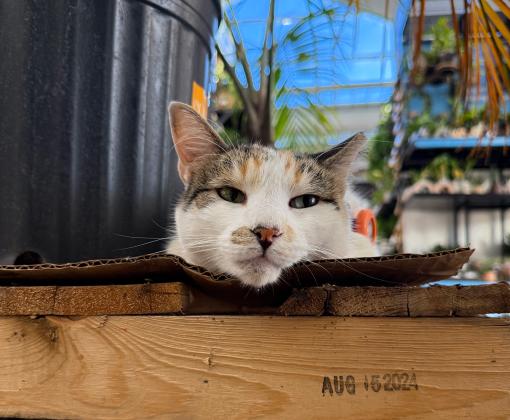
Why Is My Cat Spraying in the House and How Do I Stop It?
One of the most common behavior complaints about cats is inappropriate elimination. There are two kinds:
- A cat not using the litter box, squatting to eliminate outside of the box on horizontal surfaces
- A cat spraying (aka marking) — when the cat sprays a fine mist of urine on a vertical surface
Fortunately, there are ways to manage both types of inappropriate elimination. If you're dealing with a cat who's spraying indoors, here's what you need to know about the potential causes of and solutions to this feline behavior.
Is cat spraying the same as peeing?
When cats simply eliminate outside the litter box, they're producing urine to relieve their bladder. But when cats spray (usually — but not always — on a vertical surface like a wall, fence, or tree), the purpose is to communicate with other cats and mark their territory. It's generally a small amount of urine that they release compared to normal elimination.
Cat urine spraying or marking is a normal, instinctive behavior. In a multiple-cat household, competition over resources might be a source of conflict and could trigger the urine-marking behavior. Cats who urine mark display a typical posture while marking, which includes backing up to the object, lifting and often quivering the tail, and treading with the back feet.
What causes a cat to suddenly start spraying?
The first step in tackling a cat spraying problem is to take your kitty to your vet for a thorough physical exam to rule out any medical issues. Even though cats who urine mark have been shown to be no more likely than cats who don't urine mark to have abnormalities on a urinalysis, medical causes can contribute to the underlying stress or anxiety that a cat might be experiencing. Urinary tract infections, metabolic diseases, and neurological disorders also can play a role in a cat starting to spray.
Cat spay/neuter and urine marking
Spraying is a far more common behavior in cats who aren't spayed or neutered. Neutering is the best way to stop a male cat from spraying, and in female cats only a small percentage will continue to spray after being spayed. (Some spraying cases are due to remnants of the ovaries being left behind or testicles that haven't descended, so it might be a good idea to discuss this with your vet.) You can check SpayUSA to see whether there's a veterinarian in your area who offers low-cost spay/neuter services.
Litter box management to stop cat spraying
Proper litter box management and cleaning can have a significant effect on decreasing urine marking in cats.
First, make the litter box as attractive as possible. Keep the box immaculate by scooping daily and cleaning the entire box every week or two with mild soap and water, rinsing completely. The box should be large enough to accommodate the cat. Most litter boxes on the market are too small; the plastic storage boxes designed to fit under a bed are often a better choice. Don't use covered litter boxes because many cats find them too confining.

See how your community is doing
Second, make sure you have enough litter boxes. The ideal number of litter boxes is one per cat, plus one. Spread the boxes around the house. Cats don't like to be disturbed while in the litter box, so put the boxes in quiet, less trafficked areas (not next to the washing machine and dryer, for instance). Also, don't put a litter box near the cat's food and water dishes.
Next, try placing a litter box in the area where the cat is spraying, and gradually, inch by inch, move the box to a more appropriate area after the cat is using it consistently. You can also try placing the cat's food or toys over the area where they were spraying.
Another option is to make the inappropriate area inaccessible — at least for a while. If it is not feasible to block off the area, there are ways to make the area aversive to the cat. Try using one of the following on the spot: plastic carpet runners placed upside down, heavy plastic, contact paper with the sticky side up, or citrus peels.
If your cat "misses" the litter box and sprays nearby areas, there are a few strategies that can help. You can create an L-shaped litter pan by placing a second box at a 90-degree angle to the first, so they form an L shape. With this configuration, urine is more likely to be confined to the box and not deposited on an inappropriate surface. Another strategy is to use a large, deep plastic bin as a litter box. Cut a hole in the front of the bin so the cat can enter and exit; the high sides will keep the cat from spraying on your wall or curtains.
The odor left behind in the soiled area should be removed by using an enzyme-based cleaner that's designed to eradicate the odor-causing bacteria. Avoid using anything containing ammonia or any other household cleaner.
Territorial marking in homes with multiple cats
Incidences of spraying increase in homes with multiple cats. If you have a multi-cat household and you think competition over resources might be a source of conflict, try creating an "atmosphere of plenty." Place food, water, and litter boxes in multiple areas throughout the house to give your cats access to these resources without having to enter another cat's "territory." Adding more cat trees or towers is a great way to expand the vertical territory available to your cats. Providing your kitties with more places to hang out can reduce some of the tension that comes from sharing living space.
Another idea to consider: Install an outdoor catio, or cattery, to enlarge your cats' living area. Catteries come in all sizes and shapes; you're limited only by your imagination. They can be large open enclosures with shelves and cubbies where cats can relax and play (and you can relax and play with them), small covered enclosures just big enough for a litter box, or something in between.
When you bring a new cat into your multi-cat home, spraying can occur as a method of establishing territorial boundaries. To reduce this possibility, confine the new cat for a while to a room with food and a litter box, away from the other cats in the household. A new cat needs time to adjust to the new house and smells of the other cats without confrontation by them. This separation period also gives the other cats time to adjust to the smell and sound of the new cat.
Other stressors that can cause cat spraying
Other factors can stress your cat and consequently influence urine marking, including new cats or people in the neighborhood or household or a change in the daily routine. Also, indoor/outdoor cats can get so overstimulated while they are outside that they spray when they come in the house.
Cats who spray near a door or window usually are doing so in response to seeing outdoor cats roaming near the house. To deter this behavior, try to block visual access by closing curtains, pulling down shades, or even physically barring the cat's access to the door or window. At the same time, use some "creative sabotage" techniques to keep outdoor cats away from the house. Try the following:
- Get motion detectors that release a spray of water, which repels cats without harming them.
- Remove bird feeders and garbage, which attract cats.
- Spread orange or lemon peels, cayenne pepper, coffee grounds, or pipe tobacco in your yard. Cats don’t like the smell of these substances.
If a new person enters the household or if you have moved recently, your cat might start marking the area or objects associated with the new element in their life. Use these methods for cats who are spraying in response to something new in the environment:
- Temporarily confine the cat to a room with food, water, and a litter box. Let the cat get adjusted to that smaller space. Then, after a few days, open the door and allow the cat to explore at their own pace.
- Don't force your cat to be sociable with a new person. Let the cat approach on their own terms. It can also help if the new person starts feeding the cat or playing with them using a favorite toy.
Finally, for any cat spraying situation, try using Feliway, a synthetic pheromone that mimics the "feel-good" pheromones cats produce. It is often successful at defusing stress in cats who are marking their territory. Also, in some cases it might be worth talking to your veterinarian about using some behavior-modifying medications. These meds can be helpful to reduce stress while you teach your cat to urinate in an appropriate place.
More cat behavior resources
Cat behavior can be quite complex. If you'd like to know more, the following books can be very helpful:
- Starting from Scratch: How to Correct Behavior Problems in Your Adult Cat by Pam Johnson-Bennett
- Your Outta Control Cat by Christine Church
- No, Kitty! A Quick-Fix A-Z Problem Solver for Your Cat's Bad Behavior by Steve Duno
- Feline Behavior Problems: House Soiling from Cornell University's College of Veterinary Medicine
If you've tried everything and are still unable to resolve your cat's spraying behavior, consider consulting a cat behaviorist. Consult a veterinarian who has undergone extensive training and education in animal behavior. You can look for American College of Veterinary Behaviorists members. Or you can find a behavior consultant through the International Association for Animal Behavior Consultants.
